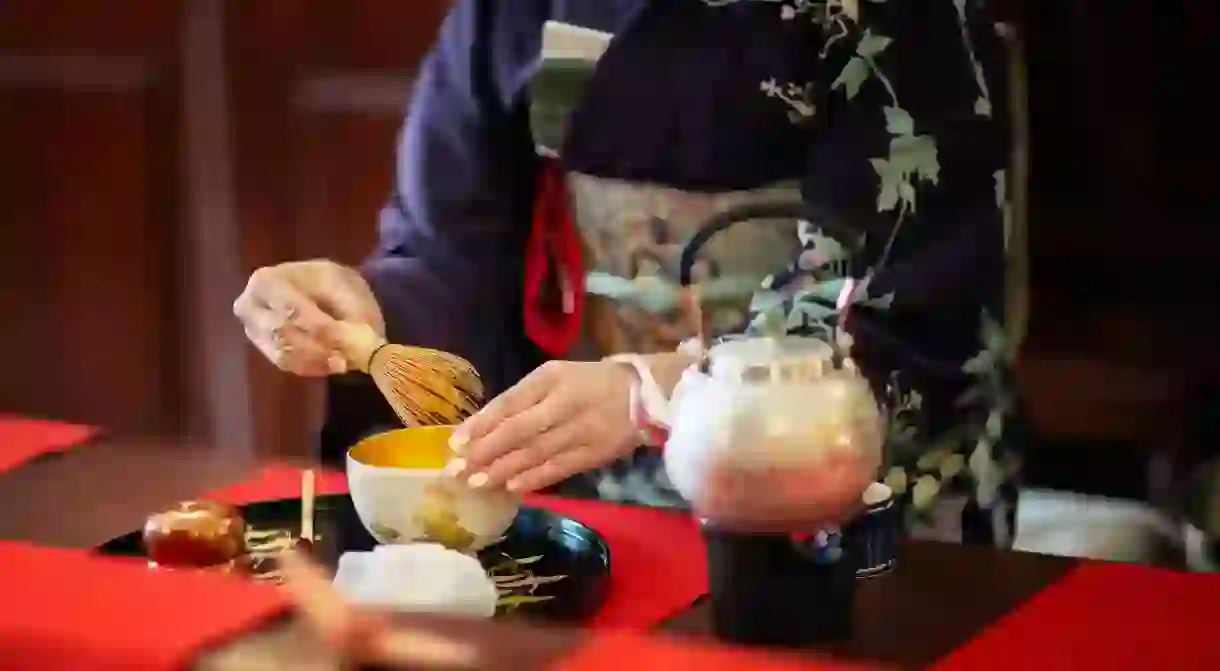The Story Behind the Japanese Tea Ceremony

A vicious dispute between an ambitious samurai and a humble monk ended up giving way to one of Japan’s most venerated institutions – the tea ceremony.
Long regarded as one of the cornerstones of Japanese culture, the chadō, or tea ceremony is a quintessential expression of aestheticism and philosophy in perfect harmony. But the story of how it came to be is an epic tale spanning centuries, including political intrigue, murder and suicide along the way.
In the beginning
The tea plant was brought to Japan in the 9th century by a Buddhist monk by the name of Eichū on his return from China, where tea had been in widespread use for centuries. Eichū served the drink to an emperor not long after and an imperial decree was issued to start cultivating tea plantations in Japan.
It would take another three centuries before tea ceremonies would become a spiritual practice. Initially, tencha, a type of matcha tea, was consumed at religious rituals in Buddhist monasteries.
But by the 13th century, tea had become a status symbol and samurai were participating in luxurious tea-tasting parties, where prizes were given out for guessing the correct variety of tea. The drink was seen as a decadent luxury, synonymous with Japanese nobility, and tensions started to emerge between opulence and minimalism in tea culture. These tensions would come to a bloody climax more than 200 years later.

Wabi-sabi and the influence of Rikyū
A seismic shift in Japanese tea culture began around the Muromachi period when tea drinking reverted to a spiritual practice. Central to this was the concept of Wabi-sabi, the belief that accepting transience and imperfection is the first step towards enlightenment.
In the 15th century, the two most important figures in the history of Japan’s tea culture emerged; Murata Jukō and Sen no Rikyū. The former was a Buddhist widely recognised as the father of the Japanese tea ceremony. He introduced the four core values of the ceremony – kin, or reverence; kei, respect for food and drink; sei, purity in body and spirit; and ji, calmness and freedom from desire. Jukō’s methods – a far cry from the social elitism that had dominated tea consumption over the preceding few centuries – meant that tea-drinking started spreading to different levels of Japanese society.
In the 16th century, Rikyū had the most profound influence on the chadō. He incorporated the philosophy of Ichi-go ichi-e (“one time, one meeting”), the idea that each individual encounter should be treasured as such a meeting may never happen again.

A bloody turn of events
It was an argument on how to make tea, which not only resulted in at least two grisly deaths but also firmly established Rikyū’s legacy. Rikyū was close with the samurai regent Toyotomi Hideyoshi, enjoying his lord’s full support as he went about spreading the ascetic ceremonial tradition, now known as “The Way of Tea”. But Hideyoshi had his own ideas on tea ceremonies, which were at complete odds with Rikyū’s minimalist, dignified approach. For the regent, tea had become political and cultural currency, a means to demonstrate power and influence as well as a win over noblemen and warriors.

Rikyū, however, was less concerned with tea ceremonies as a form of political grandstanding and doggedly pursued his notions of humility and spiritual purity. Gradually, their friendship became fraught as Hideyoshi started seeing the monk as a political obstacle. Things took a dramatic turn when, in 1590, Hideyoshi ordered one of Rikyū’s disciples to be executed. Then, one year later, the regent ordered his former tea master to commit suicide. With characteristic selflessness, the monk obeyed his lord’s decree and in his final moments composed the following poem, which he addressed directly to the dagger he used to kill himself;
“Welcome to thee,
O sword of eternity!
Through Buddha
And through Daruma alike
Thou hast cleft thy way.”
Rikyū’s violent end gave way to three schools, which pledged to continue his tradition, guiding it away from the samurai and ruling class and towards the townspeople of Japan. In the early 20th century, Okakura Kakuzō wrote The Book of Tea. One passage in particular sums up the tea ceremony’s raison d’être, a practice that is still carried out in Japan to this very day:
“Teaism inculcates purity and harmony, the mystery of mutual charity, the romanticism of the social order. It is essentially a worship of the Imperfect, as it is a tender attempt to accomplish something possible in this impossible thing we know as life.”














